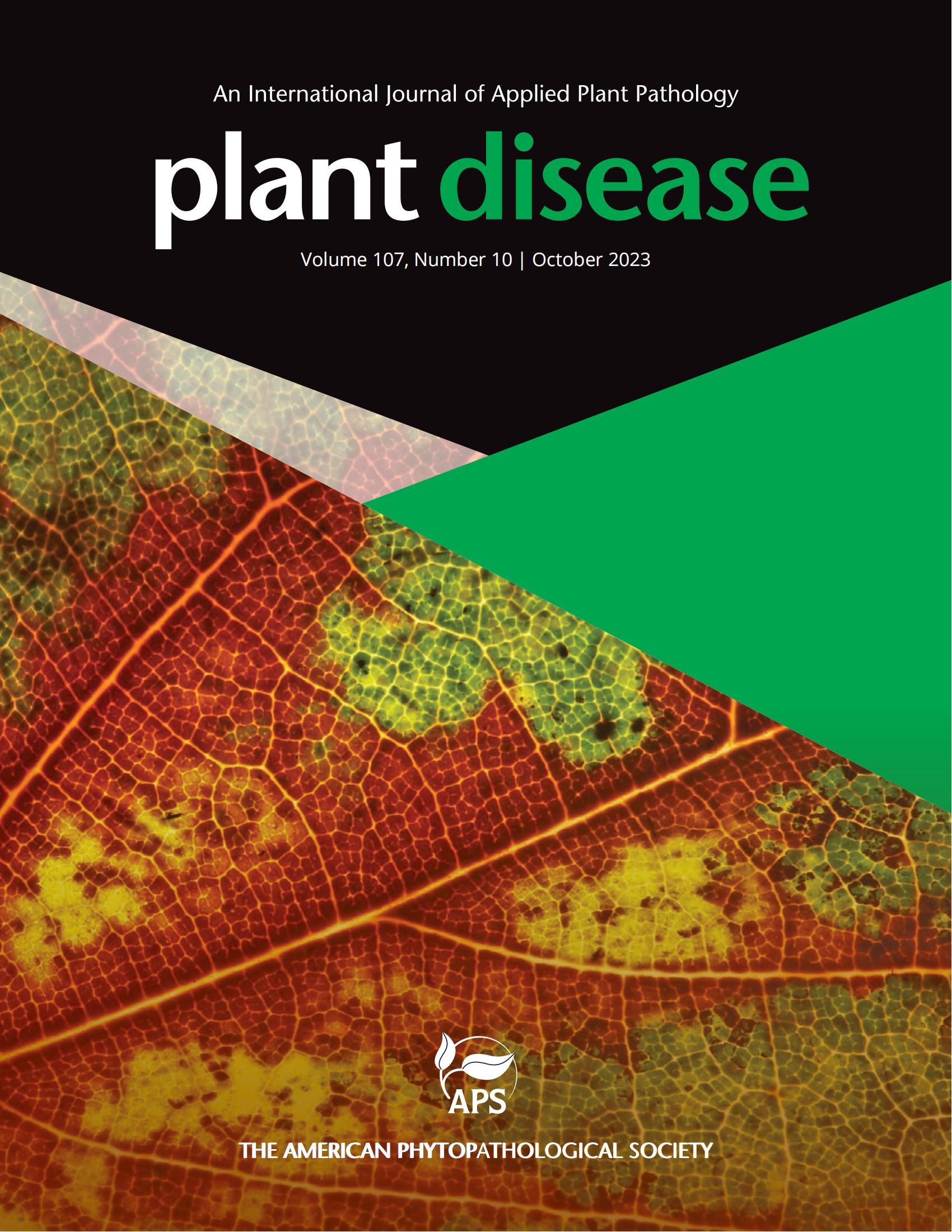在美国花生中检测到大豆静脉坏死病毒(SVNV)的首次报道。
摘要
在2024年花生(arachhis hypogaea L.)番茄斑点病病毒(TSWV)筛选过程中,从阿拉巴马州的三个地点收集了36份表现番茄斑点病症状的植物样本:Brewton农业研究单位(BARU), Brewton, AL;美国海德兰市Wiregrass研究与推广中心(WGREC)和墨西哥湾沿岸研究与推广中心(GCREC), Fairhope, AL。在所有样本中也观察到叶面坏死症状,与TSWV无关(补充图1)。症状从中度浅棕色到沿中静脉和外侧静脉的严重深色坏死不等。采用ELISA (Agdia Inc ., usa)检测4种正孢子病毒:TSWV、花生环斑病毒(GRSV)、番茄绿斑病毒(TCSV)和大豆静脉坏死病毒(SVNV)。所有样本均为TSWV阳性,GRSV和TCSV均为阴性;然而,一个样本对SVNV (BARU 4)检测呈阳性。以前有报道称SVNV不会感染花生(Zhou and Tzanetakis 2013)。36份样品使用SVNV核衣壳(N)蛋白特异性引物进行RT-PCR (Shehata et al. 2024)。36份样本中有24份SVNV阳性(12份来自BARU, 2份来自WGREC, 10份来自GCREC)。扩增的条带强度低于阳性对照,可能表明SVNV滴度较低,这可能解释了elisa结果为阴性。按照制造商的说明,使用CloneJET PCR克隆试剂盒(ThermoFisher Scientific)克隆这些条带,并送去Sanger测序。得到的SVNV-N序列提交到GenBank,编号为PQ821900-905。该序列与来自田纳西州的SVNV (GCF_004789395.1)的核苷酸(nt)和氨基酸(aa)同源性分别为98.19%和96.75%。与TN菌株相比,鉴定出9个保守氨基酸突变,与大豆中发现的氨基酸突变相似(Shehata et al. 2024)。此外,RT-PCR也用于TSWV- n检测(Martin et al. 2024), 26份样本检测呈阳性(12份来自BARU, 3份来自WGREC, 11份来自GCREC),这证实了阳性样本中同时存在SVNV和TSWV(补充表1)。需要进一步研究SVNV和TSWV的共感染、潜在的基因组重组及其机制,以了解这些病毒之间的相互作用。这些相互作用可能会对阿拉巴马州的豆类产量产生不利影响,到2023年,豆类产量将达到3.15亿美元(大豆和花生,美国农业部2023年)。由于TSWV和SVNV都是由烟草蓟马(Frankliniella fusca)传播的(Keough等人,2016;Hameed et al. 2022),这可能是SVNV被引入花生的方式。这是美国首次报道在花生中检测到SVNV,表明SVNV自发现以来一直在适应新的宿主(Tzanetakis et al. 2009;Zhou et al. 2018)。During the screening of peanuts (Arachis hypogaea L.) for tomato spotted wilt virus (TSWV) in 2024, 36 plant samples expressing symptoms of tomato spotted wilt were collected from three locations in Alabama: Brewton Agricultural Research Unit (BARU), Brewton, AL; Wiregrass Research and Extension Center (WGREC), Headland, AL; and Gulf Coast Research and Extension Center (GCREC), Fairhope, AL. Foliar necrosis symptoms, not typically associated with TSWV, were also observed in all samples (Supplemental Figure 1). Symptoms varied from moderate light brown to severe dark necrosis along the midveins and lateral veins. Samples were tested for four orthotospoviruses: TSWV, groundnut ringspot virus (GRSV), tomato chlorotic spot virus (TCSV), and soybean vein necrosis virus (SVNV) using ELISA (Agdia Inc, U.S.A.). All samples were positive for TSWV and negative for both GRSV and TCSV; however, one sample tested positive for SVNV (BARU 4). SVNV was previously reported not to infect peanuts (Zhou and Tzanetakis 2013). The 36 samples were subjected to RT-PCR using specific primers for the nucleocapsid (N) protein of SVNV (Shehata et al. 2024). Twenty-four of 36 samples were positive for SVNV (12 from BARU, two from WGREC, and 10 from GCREC). The amplified bands showed lower intensity than the positive control, possibly indicating a low titer of SVNV, which may explain the negative ELISAs. Following the manufacturer's instructions, these bands were cloned using the CloneJET PCR Cloning kit (ThermoFisher Scientific) and sent for Sanger sequencing. The resulting SVNV-N sequences were submitted to GenBank under accessions PQ821900-905. The sequences demonstrated 98.19% nucleotide (nt) and 96.75% amino acid (aa) identities with SVNV from Tennessee (GCF_004789395.1). Nine conserved amino acid mutations were identified compared to the TN strain, resembling those found in soybeans (Shehata et al. 2024). Additionally, RT-PCR was also utilized for TSWV-N detection (Martin et al. 2024), and 26 samples tested positive (12 from BARU, three from WGREC, and 11 from GCREC), which confirmed the presence of both SVNV and TSWV in positive samples (Supplemental Table I). Further research is necessary to investigate co-infection between SVNV and TSWV, potential genome reassortment, and its mechanisms to understand the interactions between these viruses. These interactions could adversely impact legume production in Alabama, valued at $315 million in 2023 (soybean and peanut, USDA 2023). Since both TSWV and SVNV are transmitted by tobacco thrips (Frankliniella fusca) (Keough et al. 2016; Hameed et al. 2022), this is likely how SVNV was introduced to peanuts. This constitutes the first report on the detection of SVNV in peanuts in the United States, suggesting that SVNV has been adapting to new hosts since its discovery (Tzanetakis et al. 2009; Zhou et al. 2018).

 求助内容:
求助内容: 应助结果提醒方式:
应助结果提醒方式:


